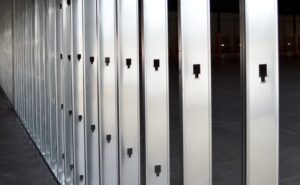An apartment building currently under construction caught fire recently in the southwest Las Vegas valley. The fire rapidly spread due to unfinished wood framing in the $90M structure, known as KAKTUSlife, according to Brian O’Neal, assistant chief with the Clark County Fire Department.
The apartment complex was approximately 75% complete. Fortunately, no individuals were reported to be inside the structure at the time of the incident, and no injuries have been reported.
Building to Prevent Fires
KAKTUSlife was intended to have 614 residential units, according to 8NewsNow.
This unfortunate event emphasizes why many builders are turning to cold-formed steel (CFS) framing for low and mid-rise projects. Steel can’t burn, because it contains no elements that can serve as fuel for a fire, provides no means for a fire to start and can’t contribute to fire growth or fire spread. Also, steel does not contribute to the generation of smoke and toxic combustion products in fires.
Steel studs simply do not ignite when exposed to a 500 degree Fahrenheit temperature, says TheBigRedGuide. Without the ability to add fuel to a spreading fire, steel studs can help protect the integrity of a structure. In fact, metal studs can even contain the spread of a fire.

Unlike other construction materials, metal studs are 100% noncombustible, making them eligible for use in Type I buildings where fire-resistance standards are most stringent.
5 Reasons to Use Steel Framing
A recent BuildSteel article, Don’t Get Burned: Steel for Fire Safety and Insurance Savings, highlights 5 reasons to use CFS:
- Steel is non-combustible
- Steel maintains its non-combustibility
- Steel-framed buildings lower the fire risk to workers and occupants
- Steel-framed buildings lower the impact on municipal fire services
- Steel-framed buildings tend to cost less to insure
Building Codes and Fire Risk
Building codes recognize steel framing as non-combustible construction. The codes make CFS eligible for use in Type I buildings, which have the most stringent fire-resistance requirements.
CFS framing is also common in Type II buildings, which are required (with few exceptions) to be built of non-combustible materials.
Buildings of non-combustible construction Types I and II are permitted to have larger areas and heights compared to buildings of combustible construction types because non-combustible construction contributes to reduced risks of fire ignition, fire growth and fire spread.
The construction of mid-rise wood frame buildings continues, despite the risks of fire. Unfortunately, the number of devastating fires is growing.
“The move to relax building codes and permit wood framing at heights above the typical four-story limits has been driven by the relentless pursuit of cheaper construction methods and materials,” says Larry Williams, Steel Framing Industry Association.
In this video, provided by the Steel Framing Industry Association (SFIA), Harry Jones II, SE, principal at DCI Engineers, tells the story of how a mid-rise CFS framed building performed during research tests that subjected it to fire and simulated earthquakes using the world’s largest outdoor shake table.
Additional Resources
- Steel Framing Helps Stunt Fire in Iowa Building
- The Framing Material That Can Lower Your Insurance Premiums
- Don’t Get Burned: Steel for Fire Safety and Insurance Savings
